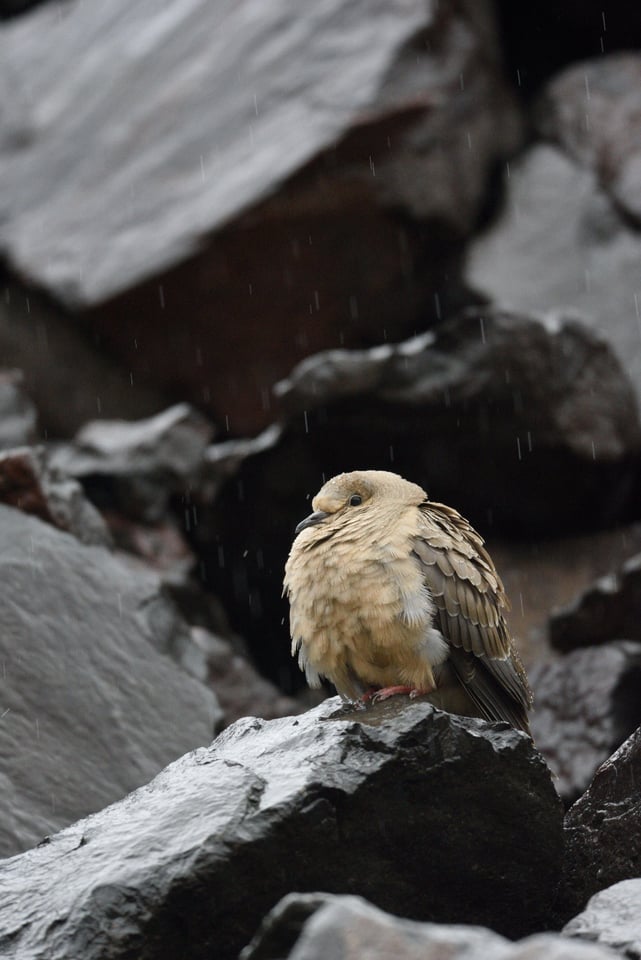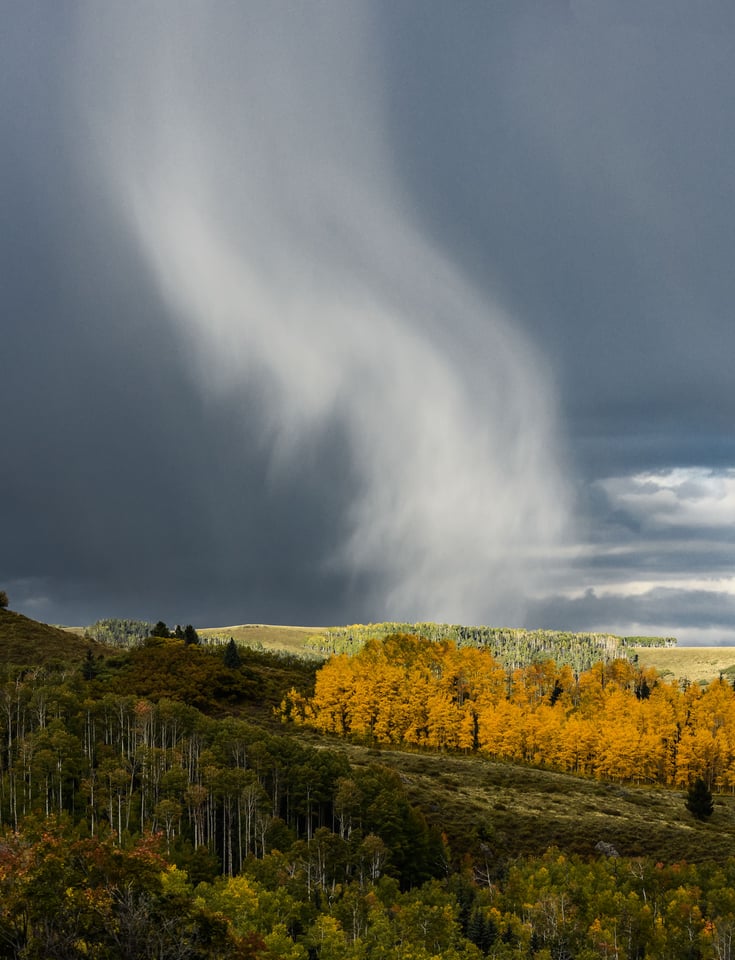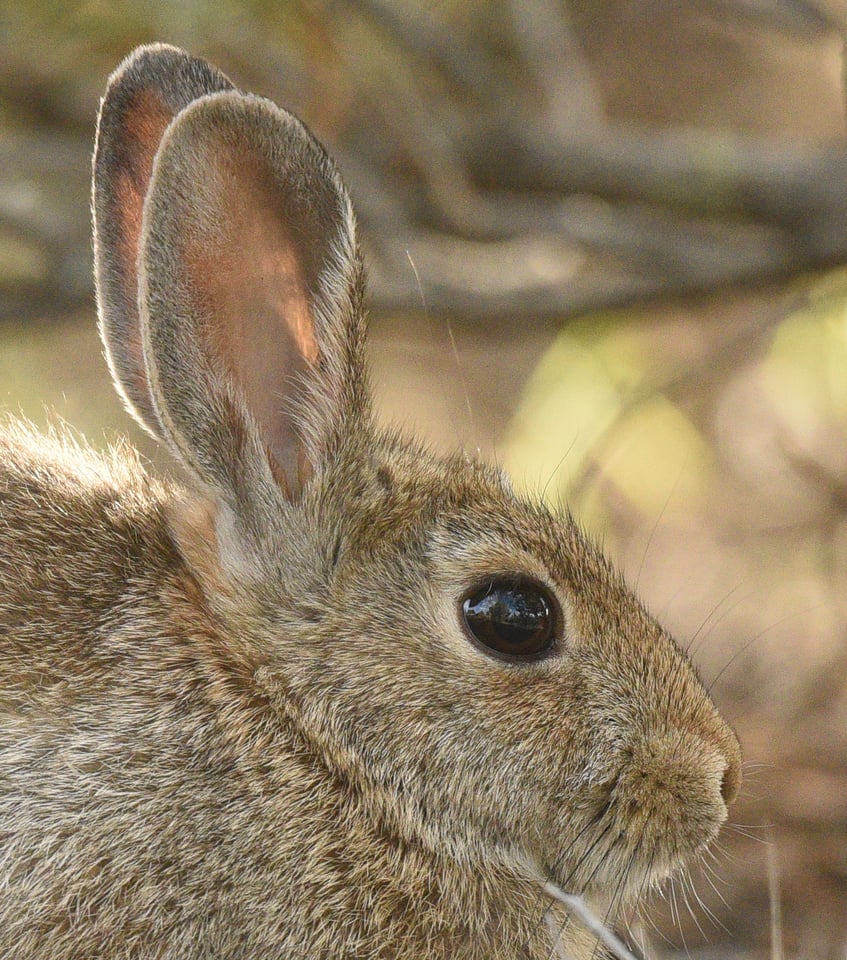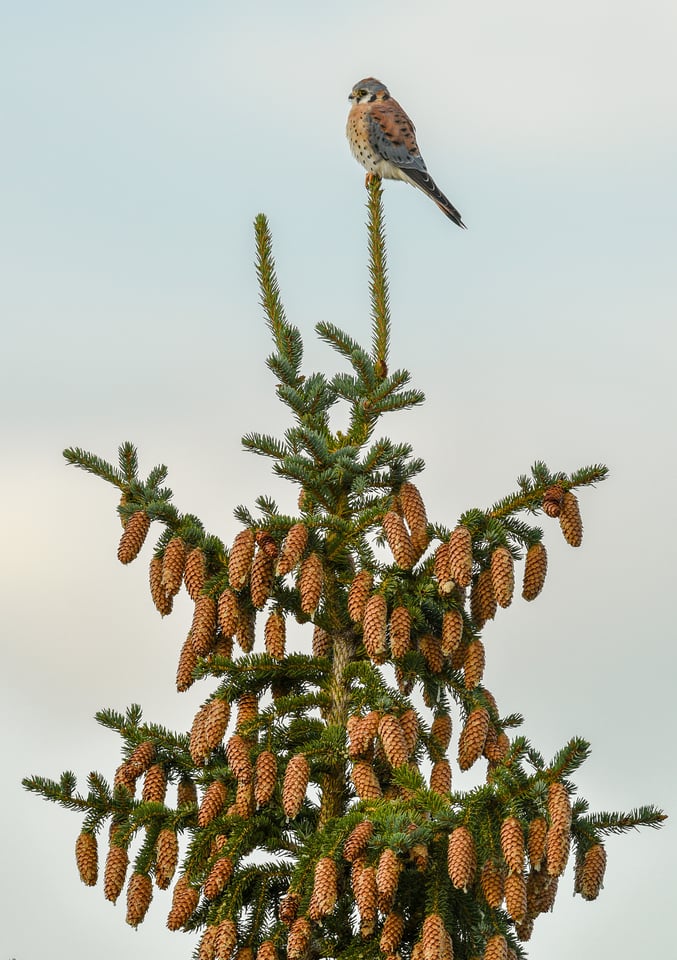Just when my wallet was getting over the hangover from buying a D810, along comes the Nikon D750, a 24mp full frame DSLR with an improved AF-system and 30 percent faster burst rate than the D810. Both are great attributes for the wildlife shooter. Moreover, the D750 sports a new 24mp sensor that’s touted as even better than that in the D600 and D610. I always liked the files my D600 cranked out – could the D750 files look just as yummy and have even less noise? I told myself not to touch the D750, that nothing good could from having a fling while still on my D810 honeymoon, but the D750 was so light and sleek and I was oh so weak…
At first glance the D750 looks like the replacement for the D600/610 series – a full frame DSLR for the photographer making the step up from DX. The tilting LCD screen and built-in Wi-Fi scream enthusiast camera. Then again the -3EV AF-system and 6.5 fps burst rate hint it might be closer to a D810 than the D610. So which is it? I got my shameless paws on it for a 48-hour fling in the San Juan Mountains of Colorado with instructions to go shoot wildlife in an area I’d never shot in before. This was going to be fun.

Before I even attached the big glass, it started snowing. The animals proved to be much smarter than I and hunkered down somewhere sheltered and hidden. The only breathing creature I saw was this lone Mourning Dove trying to fluff up and stay warm.

When the dove flew off I was out of models. Time to point the telephoto at some landscape subjects.

The next morning dawned partly cloudy, giving some interesting landscape opportunities in the high country and a chance to check file quality.
Table of Contents
Resolution

The D750 files packed in plenty of detail – I could blow this up to 16”x20” no problem and let my friend and commercial photo guru Zicky stick his nose up right to the glass and go away in tears (either from squinting so hard and/or from not finding any imperfections to point out). Ditto with these next shots.


Wow, you can almost read the initials carved in the aspen trunks. Does that say “NM+D800E 4ever” on the fifth tree from the left side in the fourth row up? Which brings us to the question of can the D750 compete with the new king of landscape DSLRs, the D810?
First a disclaimer – I usually shoot in RAW, but these images were all shot as jpegs because my preferred editing software Lightroom does not yet support the D750 (give Adobe a few weeks to reverse-engineer the software then RAW support will be available). Many of these files have tweaks added in post that increase noise more than if I had edited the RAW file.
That said the D750 jpegs looked great to me – nice colors, tons of detail, well-controlled noise. Unless your resolution demands are very high because you have an uber-picky commercial client or terminal case of pixelitis the D750 files should be more than adequate for any output viewed at a realistic magnification and viewing distance. Nevertheless if you aspire to having your prints cover an entire wall in your heart surgeon’s office and you really need more megapixels you can always stitch several images together and outdo a non-stitched D810 shot. (The panorama leading off this review was stitched from three frames and even with the top and bottom cropped away, measures 52 mp – that will print to four feet wide at an eye-straining 300 dpi – hmmm if you’re going to get that uh, well, you know, perhaps it would be a better fit at the proctologist’s office.)
Noise

Yeah, the high ISO and shutter speed on the above shot look more like something I would use for shooting hawk mid-air courtship rituals, which is just what I was doing when I glimpsed this nice instant of light on the aspen groves. No time to change settings. Less than a decade ago a 1600 ISO landscape would be noisier than a Who concert. How things have changed. The D750 handled this handheld ISO 1600 landscape just fine.
Let’s jack the ISO up to 4000 (gulp) and shoot handheld telephoto detail shots deep in the grove.

This is nearly full frame and has 25 luminance and 33 color NR applied to the jpeg in Lightroom. Unless I start mouth breathing and hit the 1:1 button, this doesn’t look bad. At 1:1 I can see the unprocessed background getting noisy, particularly with color noise. I’ll be interested to see how the RAW file processes later with the sharpening masked and some noise reduction applied.
Because the D750 pixel sites are larger than the D810’s, the D750 is less prone to noise. One of the only qualms I have about the D810 is that it produces noisy files once you exceed triple-digit ISOs. You can go back to my D600/D810/D4s comparison if you want to view comparison pics. This should be a non-issue for landscape photographers as unless it’s windy, you’ll likely be shooting on a tripod at base ISO where the D810’s image quality is unbeatable. The D600 controlled noise very well and if this rabbit has anything to say about it, the D750 does even better.

At last, some wildlife to point my lens at. This Cottontail was also shot at 4000 ISO, but for the peepers out there I’ve posted this frame at 100% with no processing outside the D750’s default standard jpeg settings. The D750 is rated to shoot up to ISO 12800 – stay tuned for Nasim’s high ISO tests.
Wildlife Photography
Key attributes for a wildlife camera are burst speed, buffer size, AF-performance, and high ISO performance. Can you say D4s? Can you afford D4$? If so, go out and buy one and we’ll excuse you from reading the rest of this. If not, read on and we’ll let the D4s kick back and chuckle at the lesser full frame Nikons’ efforts. For someone on a budget, the D750 looks tempting. All the landscape shots here and many of the wildlife shots were taken with the D750 and the Tamron 150-600mm combo (read our detailed review). Together they cost half as much as a D4s body alone and only 70 bucks more than a D810 sans lens.

Here’s a Muley with the D750/150-600 combo.

And it’s not too shabby with Dark-eyed Juncos either (at ISO 4000 no less).
Burst Speed
The D750 rips off frames at a respectable 6.5 fps. Compared to the D810’s 5 fps in full frame this is a huge difference. You have a 30 percent better chance of nailing the shot than with a D810 when you are in full frame Spray-n-Pray mode.

Spray-n-Pray in action and I don’t mean people praying for rain in Colorado. Blasting off a 6.5 fps sequence allowed me to pick a frame where the birds were in positions I liked. It was raining pretty good at the moment and the D750 (and attached photographer) got cold and wet. Both survived though – nothing a towel and a single malt couldn’t fix.
In comparison the D610 can shoot 6 fps. The D810 almost catches up when put in 1.2x crop mode (24mp) or 1.5x DX crop mode (15mp) where it can crank 6fps. Slap the battery grip on the D810 with the optional door and an EN-EL18a (D4s battery) and you can get to 7fps in DX mode. The D750 still shoots only 6.5 fps in 1.2x and 1.5x crop modes. So in reality there is little difference between the D610, D750, and D810 when it comes to burst speed – nothing I would base a buying decision on. (As a side note, before I got the 11 fps D4s my main wildlife body was the 16mp DX D7000 which shoots 6fps. I got a lot of shots published from that. Burst rate isn’t everything.)
In 1.2x or 1.5x mode the D750 shows a black frame inside the viewfinder – the 1.5x frame is fairly obvious but the 1.2x frame is faint. It would be easy to have one’s subject spill over the frame and get cut off. The D810 gets around this by having the viewfinder go dark around the frame if you set custom setting a6 “Af point illumination” to off. The D750 didn’t have the same feature. Crop mode could be used to shoot DX lenses, save on memory and/or stretch out the buffer.
Puny Buffer
Here’s where the D750 is crippled as a wildlife camera. When shooting full frame RAW you buffer out after 15 shots (assuming you are using a memory card with 95mb/sec write speed) – in just over 2 seconds at full burst rate you’ll be done shooting and start waiting for the buffer to clear. No big deal if you’re shooting tortoises, sloths or Nebraskans, but if you’re looking to capture continuous action this isn’t the camera for you. The D810 shoots 28 full frame RAW images before buffering out (all these RAW comparisons are at 14 bit lossless compressed). This increases to 33 frames in 1.2x mode yielding an equivalent 24mp image. The D810 is the clear winner here.

This Raven was repeatedly clearing its throat and I buffered out several times while trying to capture the peak of action.
Improved Autofocus
Quick accurate focus is essential for wildlife photography. No matter how fast your burst speed, how huge your buffer or how noiseless your files are, if your shots are out of focus they’ll be headed for the trash.

This Red-tailed Hawk threatened to rip my shutter finger off if I didn’t nail focus on his portrait.
The D750 has the same Multi-CAM 3500 FX AF sensor as the D810 and the Big Boy D4s. But wait, a closer look at the spec sheet says the D750 has the Multi-CAM 3500 FX II. What’s the difference? The 3500 FX II is rated down to -3EV instead of the -2EV rating of the 3500 FX. If that doesn’t get your heart racing, you might be legally dead. But what does this mean in real life?

The D750 had no problem with this easy subject – a nice contrasty chipmunk against a non-contrasty background. Unless you forget to switch your camera from MF to AF any DSLR made since Madonna was still hot should nail this shot.

Now this is getting a bit trickier. We have a Northern Flicker surrounded by a busy background. This was shot in D9 or D21 AF configuration, my general go-to settings for birds. In this mode I can put the priority focus point on the birds face and bingo. The D810, D4s and D610 would also nail this shot. How about upping the ante?

Here I’m going for a moody shot of this Great Blue Heron as seen through dense vegetation (what would a wildlife camera review be without a GBH shot?). I had to resort to manual focus on this because the D750 (or any other DSLR I’ve shot) couldn’t tell the difference between the heron’s eye/beak and all the branches I was shooting through and just kept searching back and forth. Ha! I’m smarter than the EXPEED4. This situation would give any DSLR fits.
After the first 24 hours I couldn’t see a difference in AF performance between the D750 and D810 other than the D750 array seems packed a bit narrower so you might end up focusing and recomposing a bit more than with the D810. I resorted to drastic measures. I slipped out of the camper at night, left the door ajar to let a tad of light leak out, then tried to focus on a nearby boulder. It was so dark I couldn’t tell if the 810 or 750 were focusing or just searching until they got tired – only clicking the shutter and checking the exposures later showed a difference. The D810 never locked focus. The D750 managed to lock focus, but only about 10% of the time. This was a poor test – the D810 got an F and the D750 got a D-. How else could I check for a difference? Bring on the cute little birds.

Other than this being the best shot of a Mountain Bluebird drying out after a rainstorm ever taken, what is the significance of this shot? Well if you checked the EXIF you already know. This was shot with the Nikkor 800mm f/5.6 mated to the TC-17E II for a whopping 1350mm focal length. Yes, the much maligned marshmallow soft TC-17EII 1.7x teleconverter actually kicks butt on my 800mm. When you add a 1.7x teleconverter to a f/5.6 lens it scrunches the maximum aperture down to a measly f/9.5. There isn’t a Nikon body alive that is rated to autofocus at such dim light levels. The D810, D4s, D610 and D750 are all rated to f/8 tops. However the D750 managed to grab focus and capture the shot. I tried repeating the feat with the D810 and 800/1.7x combo with results so lame I won’t show them in public. The next day (after I had to return the D750 to Nasim) I took the 800/1.7x out with both the D810 and D4s to further check this out. This time it was contrasty sunny conditions and both bodies managed, after some hunting, to lock focus on a subject but only when I used the center AF point (most accurate on all DSLRs). In comparison, under dimmer softer light the day before, the D750 managed to focus this f/9.5 rig with most of its focus points, even some on the far edge of its array. The D750 hunted as well, but not as much as the D810 or D4s.

Here’s the missus, shot with the 800/1.7x but wide open (hubby was shot stopped down to f/11).

And at 100% – we’ll wait for the peepers to pop.
The number of keepers I got with the D750 and the 800/1.7x combo made me want to buy the body right there. Imagine how powerful this could be for shooting tiny and uncooperative birds. If you are one of the chosen (read “touched”) few to own the Nikkor 800mm, but don’t have a 1.7x teleconverter here is how it does with the supplied 1.25x teleconverter.

The Red-tailed Hawk portrait earlier was shot with the same 800/1.25x combo used with this Kestrel.
I wish I had some classic bird in flight images to share, but the opportunity didn’t materialize – the only tracking I got to test was from long distance in D51 mode and the D750 did fine as would the D810. The D600 has a smaller AF array and it’s easier to lose lock on your subject if it gets out of the center of the frame.
Light Weight
The D750 is a few grams lighter than the D610 and 15% lighter than the D810 (130g, or ~5 ounces less). When coupled with the Tamron 150-600mm this made for a delightfully portable combination – at under 6 pounds this is about half the weight of a D4s with 500mm f/4 attached.
Bonus Features
The D750 has several potentially useful features I didn’t have time to check out.
First is a tilting LCD display. I could see this coming in handy for several wildlife applications – getting the tarantula eye’s view when doing macro work close to the ground, or hoisting it overhead to view over obstructions.
The D750 has built-in Wi-Fi. Beyond instant publication of blackmail shots (can’t wait to post a bareass shot of Bobby the Baboon on his Facebook page), the Wi-Fi allows use of a tablet, smartphone or Camranger as a separate monitor/controller, which seems like a cool idea for remote shooting.
Nitpicking
The D750 eyepiece popped off only a day in – my D600 eyepiece took months to fly off and go missing – this is a trait of all the Nikon’s that share the same eyepiece. Fortunately these are cheap to replace, but Nikon should just fix this.

Another thing Nikon should fix – the D750 comes with the gaudily-embroidered Nikon D-Kapitator™ camera strap. Why does Nikon continue to supply these painfully useless straps? They just get thrown out within days and replaced with a padded third-party strap so free advertising can’t be the reason. Does anyone at Nikon actually shoot Nikon gear? Even the 8.5lb Nikkor 500mm f/4 comes with the same lame strap (complete with RaZr-Wire™ technology). Attach the burly D4s to the 500mm and you have a combo you could sling over the neck of a moose and instantly get a full head mount.
The Bottom Line

Is the D750 (MSRP $2300) worth half a grand more than the D610 ($1800 with current $200 rebate)? If you shoot wildlife yes. If you just shoot landscapes no.
Is the D810 (MSRP $3300) worth a grand more than the D750? If you shoot continuous frisky wildlife action, yes. If your wildlife is lethargic and you don’t need a decent-sized buffer, no. If you shoot landscapes and share your photos on the web and/or don’t print bigger than 16×20, no. If you shoot landscapes professionally and have picky clients or print huge, yes. And if you shoot lens charts for a living, hell yes!
Hi I got the D750 2 weeks 1,5 week ago. I don’t know how to work with this camera very weel yet. But all my pict come out blury. I need to buy some good lenses and after looking at this photos and read I got a mllot more motivation to move on… Which Lens are best for wildlife photography in geral expecialy birds? Sigma 150-600 mm Sport or the Nikon 200-500 mm? Best regards
Something I don’t see here is what lens was use to shoot? 150-600mm is mentioned by Tamron or Sigma? Because I think Nikon is 200-500 F/5.6 constant..
Thanks
seems lucrative article about D 750, though i own one too,should we go with assumption that this is best of lot.Results are good and this is handy too,with nice price tag.Please also advise don’ts too with this camera.what another lens to have besides Nikon 24-120.
seems lucrative article about D 750, though i own one too,should we go with assumption that this is best of lot.Results are good and this is handy too,with nice price tag.Please also advise don’ts too with this camera.
i was thought of getting CANON 7D MARK II + CANON 100-400MM L IS II lens for concentrating on wildlife photography. Is this a better choice?
Hi Nasim,
The thread may be closed but just a quick question and it is good time that I checked your this article. I am contemplating buying 150-600. Which lens did you use for above pics? tammy or Sigma 150-600?
Thanks in advance.
Ashraf, it was the Tamron 150-600mm – the Sigma 150-600mm is on its way for testing.
Hello Nasim
congratulations for yr fantastic work,I have a question, is normal (Nikon D750) when
magnify an image (the camera) in 1.5X, 2.0X the image is blurred, the same
imagine is perfect if you zoom in 0.5X and 1.0X.
Many thanks
Nat
I’ve been looking over tons of D750 images the last few days and it seems a little noisy, even at low iso? More so than the 6D ata equal iso ranges.
Interesting you should mention this. A good friend and another pro photographer, a Canon shooter said the exact opposite. He was impressed that the noise level at equal ISO from his 60D seemed to be a bit noisier then his new D750. Want me to ask him if he wants to trade his 60D for your D750?
absolutely agree. I reviewed D750 when released and have to admit that the ISO wise this is great machine! There is really no problem to shoot at ISO 12800! Of course there have to be a proper postprocessing, but the result is amazing considering that ISO! I do not like the body, but the sensor in D750 is the best one on the market until now. I am saying that as D3s/D810/D700 owner.
Such a fantastic article, John. For a weekend photography fling, these bird shots are extraordinary. Thanks for the good write up.
Thank you for the truly excellent review, which goes a long way towards helping me choose between potential full frame camera purchases and the kind of lenses needed to get the best out of them. To be honest, I still can’t even decide whether Canon or Nikon are most suited to my needs and wildlife is only going to be a small part of the type of photography that I’ll be into during the months and years ahead. For everything else, Olympus and Fuji are already more than adequate. Your photos are stunning of course and I’d be proud to have produced anything even half as good.
Wonderful witty write-up and very very helpful. I am into wildlife and birds and the buffer bit if putting me off a bit….. thanks a lot for the detailed info on that!